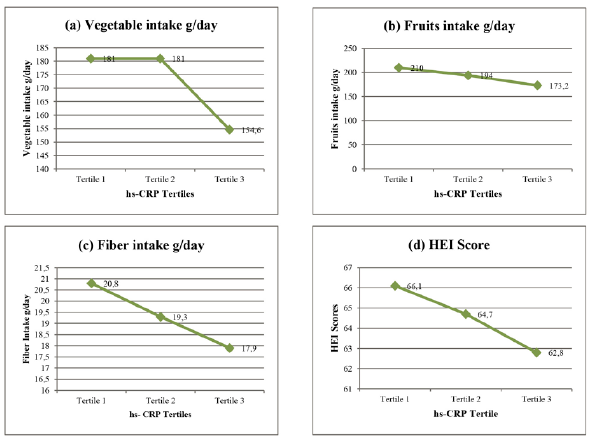F&V intake and inflammatory marker in pre-pubertal girls
High sensitivity C-reactive protein (hs-CRP) is an inflammatory marker that has been associated with obesity and considered to activate all stages of atherosclerosis1. There is broad consensus on the role of diet in influencing CRP levels. Particularly, the consumption of F&V- major source of antioxidant vitamins- has been related to lower CRP levels in several studies2-4. Similarly, a high intake of vegetables is associated with a low CRP level according to the IDEFICS study in European children5. However, the influence of dietary patterns on inflammation in children remains under study. The aim of this study was to analyze the influence of diet on hs-CRP levels in a pre-pubertal population.
This study included 571children aged between 6 and 8 years old – 301girls and 270 boys. We have ensured that all of the subjects included were free of metabolic, endocrine, liver or kidney disorders, and had an hs-CRP level ≤10 mg/L to avoid biasing the results.
Food Frequency Diet (FFQ) adapted to primary school population was used to obtain information on food and nutrient intake.
Food consumption and nutrients intakes were analyzed by tertile of hs-CRP levels:
- Tertile 1: hs-CRP ≤0.15 mg/L;
- Tertile 2: 0.16 ≤ hs-CRP ≤ 0.61 mg/L;
- Tertile 3: hs-CRP ≥0.62 mg/L.
High intake of F&V is associated with lower hs-CRP levels in pre-pubertal girls
When analyzing nutrient intake and food consumption in boys, no differences were found.
In pre-pubertal girls, those in the lowest hs-CRP tertile had significantly higher vegetable intakes (181 g/day in tertile 1 and 2) than those in the terile 3 (154.6 g/day) (Figure 1a). Similarly, fruit intakes were the highest in pre-pubertal girls in the lowest hs-CRP tertile (210 g/day in the tertile 1 and 194 g/day for the tertile 2) compared to those in the tertile 3 (173.2 g/day) (Figure 1b). This seems to be due to the high fiber content and high antioxidants levels in fruit and vegetables.
Fiber, vitamin A and E intake play a role on inflammatory marker
Fiber intakes were lower in pre-pubertal girls in the highest hs-CRP tertile (17.9 g/day) compared to those in the tertile 1 and 2 (20.8 g/day in the tertile 1 and 19.3 g/day in the tertile 2) (Figure 1c). It remains unclear how fiber could modulate hs-CRP levels; maybe, it’s related to its effects on slowing glucose absorption and modulating inflammatory cytokines production by gut microbiota6.
Besides, the study reported a lower intake of vitamin A and E in pre-pubertal girls in the tertile 3 compared to those in the tertile 1 and 2. This finding supports the fact that antioxidant nutrients may be responsible for reducing hs-CRP levels.
Regarding fatty acid, a higher intake of saturated fats was noted in pre-pubertal girls in the highet hs-CRP tertile (17,1% in the tertile 3 vs 15,7% in the tertile 1 and 16,6% in the tertile 2).
The overall dietary quality was also assessed using the Healthy Eating Index (HEI). We found an inverse significant association between hs-CRP with HEI. The HEI score of the highest tertile of hs-CRP levels in pre-pubertal girls (62.8) was also significantly lower than the HEI score in the tertile 1 (66.1) and in the tertile 2 (64.7) (Figure 1d). This score was associated with a higher intake of vegetable and a lower intake of fats.

Figure 1: (a) Vegetable, (b) Fruit, and (c) Fiber intakes and (d) HEI score by hs-CRP tertiles in pre-pubertal girls
The need of dietary guidelines to prevent high hs-CRP levels in children
These findings support the hypothesis that diet can influence hs-CRP levels at the pre-pubertal age. This highlights the importance and the need to set up dietary guidelines in preventing hs-CRP levels from childhood.
Based on: P. Navarro, O. de Dios, A. Jois, T. Gavela-Pérez, L. Gorgojo, JM. Martin-Moreno, L. Soriano-Guillen and C. Garcés. Vegetable and Fruit Intakes Are Associated with hs-CRP Levels in Pre-Pubertal Girls. Nutrients 2017 Mar; 9(3):224. doi: 10.3390/nu9030224
References
- Yeh, E.T. H. Clin. Cardiol. 2005, 28, 408–412.
- Oliveira, A.; Rodríguez-Artalejo, F.; Lopes, C. Eur. J. Clin. Nutr. 2009, 63, 1345–1352.
- Esmaillzadeh, A.; Kimiagar, M.; Mehrabi, Y.; Azadbakht, L.; Hu, F.B.; Willett, W.C. Am. J. Clin. Nutr. 2006, 84, 1489–1497.
- Wannamethee, S.G.; Lowe, G.D. O.; Rumley, A.; Bruckdorfer, K.R.; Whincup, P.H. Am. J. Clin. Nutr. 2006, 83, 567–574 ;
- Gonzalez-Gil, E.M.; Santabarbara, J.; Russo, P.; Ahrens, W.; Claessens, M.; Lissner, L.; Brnhorst, C.; Krogh, V.;Iacoviello, L.; Molnar, D.; et al. Eur. J. Nutr. 2016, 55, 2459–2468.
- Weickert, M.O.; Pfeiffer, A.F.H. J. Nutr. 2008, 138, 439–442.
